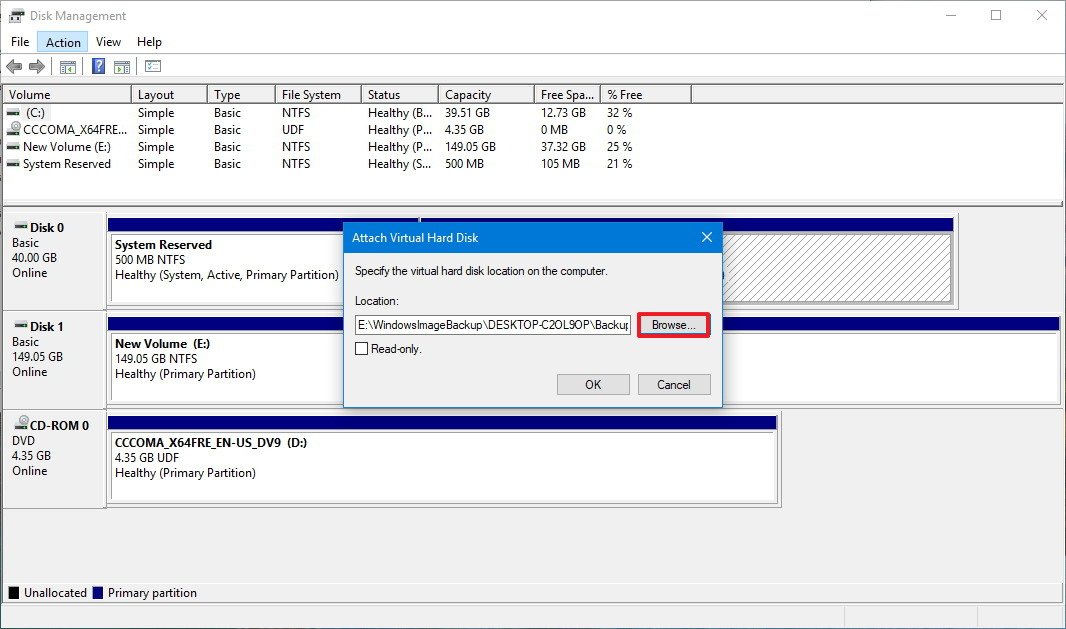How to recover missing files after an upgrade on Windows 10

The setup procedure to upgrade to Windows 10 from a previous release, or from a previous version (such as Windows 8.one or Windows 7), usually does a pretty good job preserving your files. However, in some scenarios, unexpected behaviors may occur that will cause your documents, pictures, music, and videos to suddenly disappear after the installation.
If this happens, non everything is lost just however, as at that place are a number of ways to detect and restore missing files.
In this Windows 10 guide, nosotros'll walk y'all through a few ways you tin can go dorsum your documents, pictures, music, and videos after upgrading to the latest version of the Bone.
- How to recover files removing temporary account
- How to recover files using Administrator business relationship
- How to recover files using search
- How to recover files using Windows.old folder
- How to recover files using backup
How to recover files removing temporary account
Immediately after upgrading to the latest version of Windows 10, yous may discover that your files are no longer bachelor, just this is considering you're signed in using a temporary account.
You can quickly check if you're using a temporary contour using these steps:
- Open up Settings.
- Click on Accounts.
-
Click on Sync your settings.

-
If you see a bulletin at the top that reads: "You are logged on with a temporary contour. Roaming options are currently unavailable," then reboot your computer.
Note: Information technology may take a few reboots until you see your account on the sign-in screen.
- Sign in with your account.
Once you've completed the steps, the temporary account should go away, and you lot should now be able to access your documents, pictures, and videos from your original account.
How to recover files using Ambassador account
If you're upgrading from Windows 7 to Windows ten, and you created a Microsoft business relationship during the process, your files may end up in the Administrator account, which is now disabled.
To go dorsum your missing personal files, you'll need to use the built-in local Administrator business relationship using these steps:
- Open Start.
- Search for Computer Management, click the top result to open up the experience.
-
Browse the following path:
Computer Management > Local Users and Groups > Users -
Double-click the Administrator account.

- Click the Business relationship is disabled option.
- Click Apply.
-
Click OK.

- Sign out of your current business relationship.
- Sign in with the Administrator account.
Later on completing the steps, you should see your files once more using the local Administrator account. Then the concluding affair left to do is to fill-in and restore all your files to the newly created business relationship you configured using a Microsoft account.
How to recover files using search
You tin also locate lost files using the search feature on Windows ten with these steps:
- Open File Explorer (Windows key + E).
- On the left pane, click the This PC pick.
-
On the elevation-right, utilise the search box to locate your files.

If you lot're looking for a specific type of files, you can use the asterisk (*) equally a wildcard. For instance, you can use the *.doc search query to list all of your Microsoft Give-and-take documents.
Too, y'all tin can use the File Explorer Search tab options to refine your search. For example, you can click the Advanced options drop-down menu and make certain to include non-indexed locations. In add-on, y'all can use the Kind drib-downward menu to do quick searches, including for documents, pictures, videos, music, and more than.

When upgrading to a new version of Windows x, sometimes your personal files will move to a dissimilar binder. If you're able to find your files using search, right-click one of the files and select Open up file location, and then brand sure to movement your data to the folder you want.
Show hidden files
Depending on your system configuration, you may not be able to see your files because they're hidden. On Windows 10, you can see hidden files using these steps:
- Open up File Explorer.
- Click the View tab.
-
Under "Bear witness/hide section," check the Hidden items options.

After completing the steps, try to employ the search feature again to notice your files.
How to recover files using Windows.old folder
If you installed Windows ten using the upgrade process, or you went through a custom installation without deleting the main sectionalisation, then the setup will save a re-create of your previous installation in the Windows.old folder, which you can use to recover your missing files.
To recover your files using the Windows.onetime folder, do the post-obit:
- Open File Explorer.
- On the left pane, click the This PC option.
- Double-click the Local Disk (C:) drive.
-
Double-click the Windows.old folder.

In one case yous've completed the steps, locate your personal files (likely to be stored in the "Users" folder), and move them to some other location.

If yous don't see the Windows.former folder, you may take upgraded using the clean installation process which erases everything on your figurer. Something may accept happened during the installation and copy of the previous installation was never saved. Or it'south been more than than x days since you upgraded to Windows 10, in which case the organisation deletes these files automatically.
How to recover files using backup
If none of the methods outlined to a higher place accept worked to get back your lost files, then you'll need to use a previous fill-in to recover them. But bear in mind that the steps may vary depending on the backup method you used.
Below you'll find the steps to recover your files when using the built-in organization tools and OneDrive. (If y'all used another tool, make sure to refer to your software vendor back up site for specific instructions.)
Using System Paradigm backup
If you used the System Image backup tool built into Windows ten, you won't be able to restore files individually, merely you can connect the external drive with the fill-in files and so use this workaround:
- Open Start.
- Search for Computer Management, click the acme consequence to open the feel.
-
Browse the following path:
Storage > Disk Management - Click on Activeness.
-
Select Attach VHD.

-
Click the Browse button.

- Browse to the path where you saved the fill-in. Ordinarily, it's in external bulldoze within this folder path:
WindowsImageBackup\<COMPUTER-Name>\Backup xxxx-twenty-xx xxxxxx\ -
Select the largest VHDX file.

- Click Open.
- Click OK.
-
Right-click the partition, and select the Change Drive Letter and Path option.

- Click the Add button.
-
Select a drive letter of the alphabet. (Typically, you want to apply the one that's already selected.)

- Click OK.
One time you've completed the steps, open the drive using File Explorer, locate and copy your files to your computer.
Information technology'south a skilful thought to right-click the virtual drive, select the Detach VHD option when you're done copying the files to properly remove the virtual hard drive.
Using Windows x backup feature
In the case that you're using the Windows 10 backup feature. You can quickly restore one or multiple files using these steps:
- Open Control Console.
- Click on System and Security.
- Click on Fill-in and Restore (Windows 7).
-
Nether "Restore," click the Restore my files button.

-
Click the Browse for files push.

- Browse the backup and select the files you desire to restore.
-
Click the Add files button.

- Click the Browse for folders button.
- Browse the backup and select the folders you want to restore.
- Click the Add folders push.
-
Click Next.

- Select the original location option. Or if you lot want to restore files to an alternate path, employ In the following location option.
-
Specify the new location.

- Click Restore.
- Click Finish.
After completing the steps, your files will be available in the path you specified.
Using File History
Alternatively, if you were not able to recover your missing personal files afterward an upgrade using the instructions mentioned above, you may still be able to get them back using File History.
- Open Settings.
- Click on Update & Security.
- Click on Backup.
-
Click the More options link.

-
Click the Restore files from a current backup link.

- Select the files y'all want to restore.
-
Click the Restore push button.

In one case yous've completed the steps, your lost files will be available once again on your device.
Using OneDrive
If you've been using OneDrive to backup your files, yous'll need to re-configure the sync client on your device. If you're using Dropbox, Google Drive, or another storage service, make sure to visit their support website to detect more specific instructions.
Wrapping things up
Although the upgrade process is capable of keeping your files, it's important to acknowledge that there's always a chance that something incorrect may happen. This is why it'south really important to regularly create a backup of your data (at to the lowest degree earlier proceeding with an upgrade) in cases such as this 1.
In addition, a fill-in is non only good to go your files back after an upgrade, only it can as well assist you recover from a hard bulldoze failure, or afterwards a malware infection.
More Windows 10 resources
For more helpful articles, coverage, and answers to common questions about Windows 10, visit the following resources:
- Windows 10 on Windows Cardinal – All you lot need to know
- Windows ten assist, tips, and tricks
- Windows ten forums on Windows Fundamental

Oh Honey
New study reveals Microsoft'southward time to come AR strategy; HoloLens 3 is dead
Business organisation Insider has today published a follow-upwards written report with more details about Microsoft's canceled HoloLens iii augmented reality headset. The partnership with Samsung is said to include a headset with a prepare of screens within, powered by a Samsung phone in your pocket.

Keeping it affordable
Review: Surface Laptop SE is the new standard for 1000-8 Windows PCs
Starting at just $250, Microsoft's first foray into affordable laptops for the education market is a winner. With a gorgeous design, splendid thermals, and a fantastic typing experience, Microsoft would do right to sell this direct to consumers likewise. Let'south just hope Intel tin can make a better CPU.
Source: https://www.windowscentral.com/how-recover-missing-personal-files-after-upgrade-windows-10
Posted by: stanleythistried.blogspot.com





















0 Response to "How to recover missing files after an upgrade on Windows 10"
Post a Comment